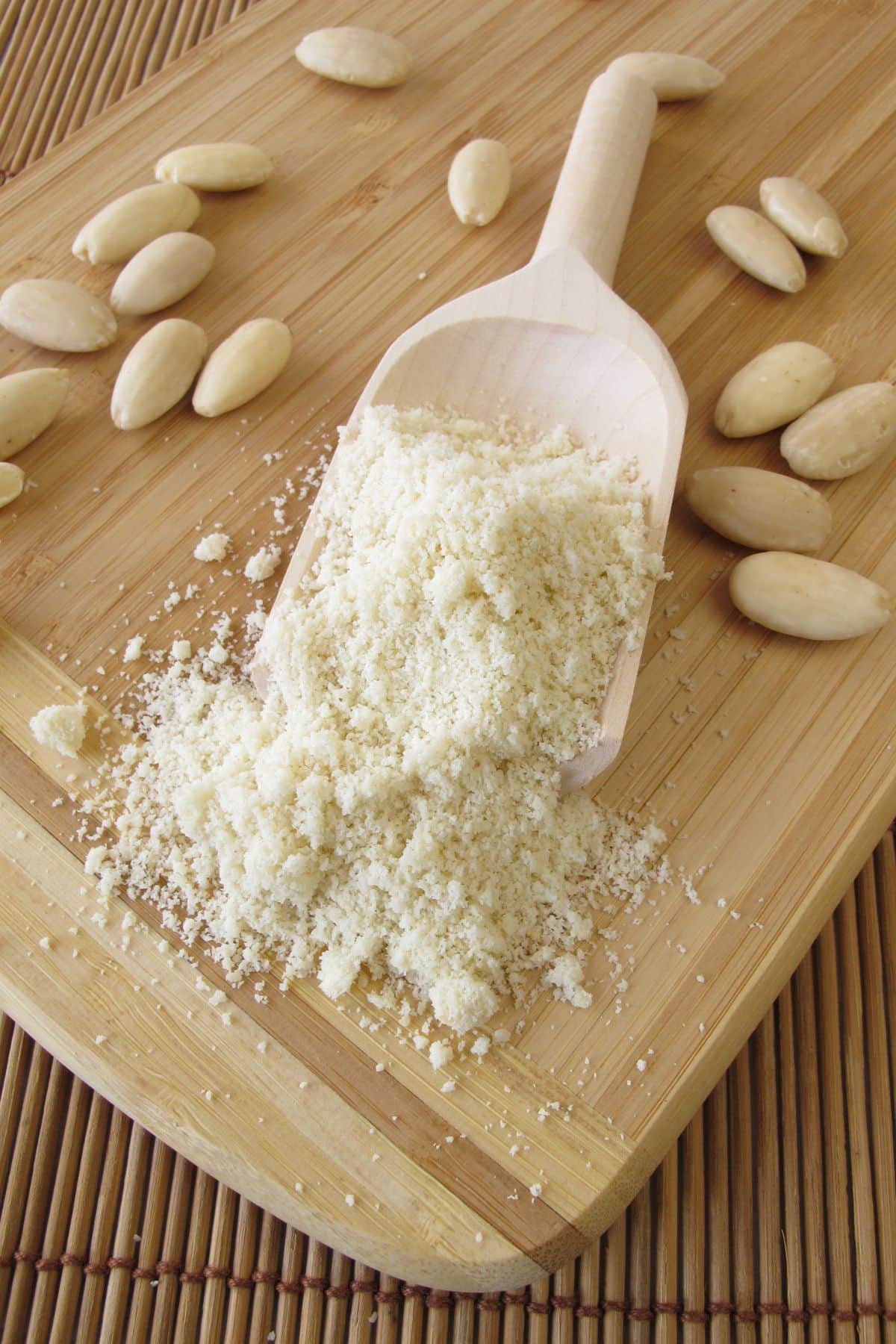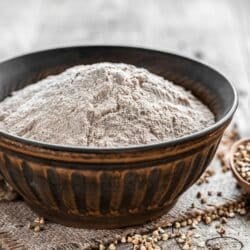7 Substitutes for Almond Flour in Baking
If you need almond flour in a recipe, but don’t have any on hand, you’re in luck! There are many great substitutes that can be used in its place. Here are some substitutes for almond flour including coconut, hazelnut, oat, all-purpose, sunflower seed, cashew, and chickpea flour.

Nutrient-rich and with a delicious nutty flavor, almond flour makes a great alternative to wheat flour in your recipes.
Baked goods made with almond flour are wonderfully moist and tender. What’s more, almond flour is lower in carbohydrates than wheat flour and totally gluten-free and grain-free.
If you’re new to a gluten-free diet or just looking for a great option to traditional flour, you’ll want to consider almond flour or other nut flours of your gluten-free baking (I love it in my Almond Flour Peach Cobbler recipe).
Uses of Almond Flour
Almond flour is paleo-friendly and ideal for low-carb and ketogenic diets. It is also naturally gluten-free, so it can be enjoyed by people with gluten intolerance or celiac disease.
Its super fine texture and yummy nutty flavor make it perfect for all sorts of dishes. It’s wonderful in cakes, cookies, muffins, and bread – giving them a moist and tender texture – and adds extra flavor to breakfast foods like pancakes and waffles.
You can also use almond flour instead of breadcrumbs as a coating for fried foods, and it makes a tasty and nutritious thickener for soups and sauces. It is really ideal for a paleo diet or a keto diet where you need to avoid white flour or regular flour.
Be sure to store almond flour in the refrigerator or freezer. Its fat content is much higher than wheat flour, so it can quickly go rancid if kept at room temperature.
Substitutes for Almond Flour
All that said, if you need almond flour for a recipe and have none to hand, there are several great substitutes you can try!
Here are my favorites, including a look at their health benefits and how they compare in taste and texture.
1. Coconut Flour
Coconut flour is a by-product of coconut milk production and is considered sustainable, so it’s an eco-friendly choice.
It has a delicious, mild flavor and is highly absorbent, producing baked goods with a softer, denser texture than those made with almond flour.
It’s nutritious, too, containing plenty of fiber and a reasonable amount of protein. Like almond flour, coconut flour is low in carbs and naturally gluten-free. It is also suitable for those with nut allergies.
Because coconut flour is so absorbent, you’ll need to adjust the amount of liquid or eggs in your recipe. As a rule of thumb, add one extra egg for every ¼ cup of coconut flour you use, in addition to the eggs called for in the recipe.
To substitute one cup of almond flour, use ¼ cup of coconut flour
2. Hazelnut Flour
Hazelnut flour has a rich and nutty taste just a little stronger and sweeter than almond flour. I find it ideal for chocolate brownies and cookies, as it gives them a more robust flavor.
On the whole, it works best in dishes with a crumbly, nutty texture, as it has a coarser texture than almond flour and doesn’t hold its form quite as well.
Like almond flour, hazelnut flour has an impressive nutritional profile! It’s gluten-free, high in healthy fats, contains a moderate amount of protein, and is rich in vitamin E. You can also use pecan flour in the exact same way.
To substitute one cup of almond flour, use one cup of hazelnut flour.
3. Oat Flour
Made from finely ground whole oats, oat flour is a nutritious substitute for almond flour.
It is an excellent source of fiber, and studies show that the beta-glucan it contains can help reduce the risk of diabetes and lower cholesterol.
Oat flour is lower in calories and fat than almond flour but is higher in carbohydrates. It is naturally gluten-free, but oat products sometimes become contaminated with gluten during the manufacturing process. Be sure to check the labeling if you require oat flour that’s gluten-free.
Oat flour is lighter than almond flour and tends to give baked goods a fluffy, airier texture.
Tip: You can easily make oat flour at home by pulverizing rolled oats in a food processor until fine.
To substitute one cup of almond flour, use one cup of oat flour.
4. All-Purpose Flour
Neutrally flavored all-purpose flour is the most economical and widely available substitute for almond flour but is not as nutritious.
It contains less protein and healthy fats than almond flour and is higher in carbohydrates. It also contains gluten, so it is unsuitable for anyone with celiac disease or gluten intolerance.
All-purpose flour gives baked goods a lighter texture than almond flour. You may like to add a little extra liquid or eggs to your recipes to make up for the lack of moisture.
To substitute one cup of almond flour, use one cup of all-purpose flour.
5. Cashew Flour
Cashew flour is an excellent substitute for almond flour because it is so similar in terms of taste and texture. It’s very mild, with a slight sweetness, and has the same buttery feel that makes foods baked with almond flour so moist and tender.
Cashew flour is gluten-free and slightly higher in carbs than almond flour, but it’s roughly equivalent in terms of fats and protein.
You can cook with it in just the same way, without needing to adjust the quantity of liquids in your recipe, so it’s easy to use as an alternative.
To substitute one cup of almond flour, use one cup of cashew flour.
6. Chickpea Flour
Also known as garbanzo bean flour, chickpea flour has a similar powdery texture to almond flour. You can buy it pre-prepared, or make your own by grinding dried chickpeas in a food processor.
But unlike almond flour, it’s not sweet and has a delicate bean-like flavor that makes it better suited to savory recipes than sweet. I find it ideal for pizzas, breads, and pancakes.
Chickpea flour is gluten-free and highly nutritious. It contains lots of protein – just over 20g per cup – and is packed with magnesium, potassium, phosphorus, and folate.
Just like almond flour, it has a fairly low glycemic index, so it helps control your blood sugar levels and leaves you feeling full.
To substitute one cup of almond flour, use one cup of chickpea flour.
7. Sunflower Seed Flour
Sunflower seeds are packed with nutrients, making sunflower seed flour another healthy choice when looking for an almond flour substitute.
Gluten-free and safe for people with nut allergies, it can be more affordable than almond flour but has a very similar texture, producing moist, tender baked goods that melt in your mouth!
It has a mild, slightly nutty flavor, and is ideal for all recipes, both savory and sweet.
Its protein and fat levels are comparable with almond flour, and it is a great source of vitamin E.
There’s just one thing to be careful of when cooking with sunflower seed flour – it has a tendency to turn green! This phenomenon is caused by the chlorogenic acid in the seeds reacting with leavening agents like baking soda or baking powder.
While completely harmless, it’s probably something you’ll want to avoid! Fortunately, all you need to do is add a tablespoon of an acidic ingredient like lemon juice or apple cider vinegar.
You can omit this step if your recipe contains chocolate, however, as its dark color will hide the green!
To substitute one cup of almond flour, use one cup of sunflower seed flour.
Bonus Substitute
I am also partial to cassava flour as a great substitute for almond flour or whole wheat flour.
You can use it in a one-to-one ratio for either of these and it can be found in most grocery stores. It’s a great gluten-free option that is also grain-free.
FAQs
Both almond flour and almond meal are made from ground almonds, but they differ in both their texture and their nutritional content. Almond flour is made from blanched almonds, which have had their skins removed. This gives the flour a finer, smoother texture that is ideal for baking.
Almond meal, on the other hand, is made from whole almonds, skin and all. As a result, it has a coarser, more crumbly texture that works well in recipes like muffins and pancakes.
In terms of nutrition, almond flour is higher in calories and fat than almond meal. However, it is also higher in protein and fiber, making it a more nutrient-rich option.
When deciding which to use in your baking, it is important to consider both the desired texture and the nutritional content of your recipe.
Yes, it’s not that hard but it can take a few steps. My favorite method is to soak my almonds, skin then, and then dehydrate them. Then, grind then in a food processor until you get a fine flour. Store your almond flour in an airtight container in the fridge for up to a few weeks and use them in your favorite gluten-free recipes.
More Articles About Substituting Ingredients You Might Like
Conclusions
As you can see, there are plenty of excellent substitutes for almond flour that you can use when baking, almost all of which are tasty and equally nutritious.
Whether you prefer the rich flavor of hazelnut flour or the subtle sweetness of cashew flour, I hope this guide has helped you discover an almond flour alternative that enhances the taste and texture of your baked creations.
Don’t forget to join my newsletter list to get exclusive clean eating recipes and tips. The newsletter is 100% free with no spam; unsubscribe anytime.
About the Author: Carrie Forrest has a master’s degree in public health with a specialty in nutrition and is a certified holistic nutritionist. She is a top wellness and food blogger with over 5 million annual visitors to her site. Carrie has an incredible story of recovery from chronic illness and is passionate about helping other women transform their health. Send her a message through her contact form.





















Carrie,
I’m so appreciative of the informative articles you take the time to write. You answer so many questions with very thorough-yet-easy-to-understand answers.
Thanks so much, and Merry Christmas to you!
Awwww thanks Tracy! Happy holidays!